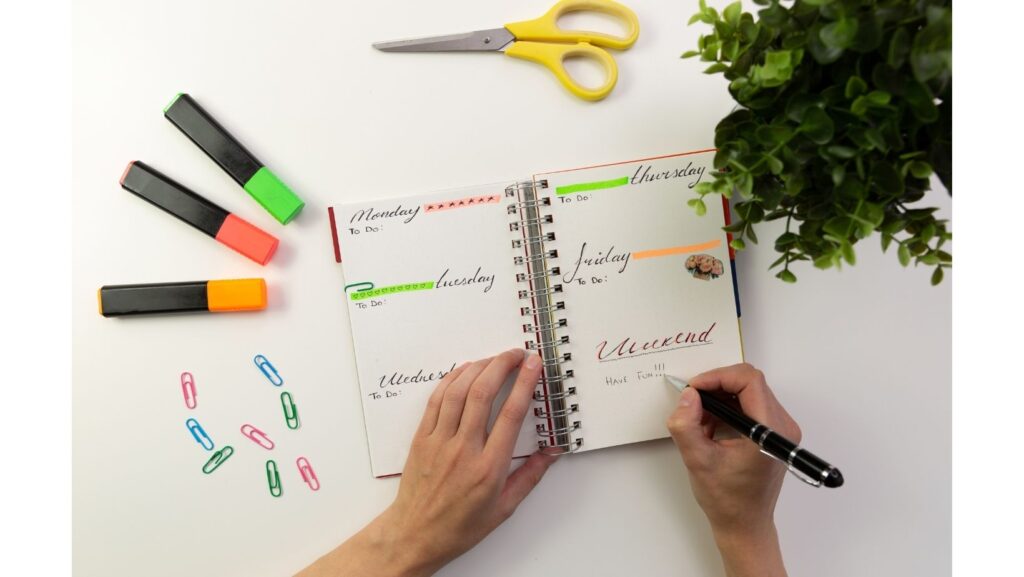How to Write An Effective To-Do List to Help You Get Stuff Done
This post may contain affiliate links, which means I’ll receive a commission if you purchase through my links (at no extra cost to you). Please see my disclosure for more information.
Being able to write an effective to-do list is an absolutely essential part of being productive and managing your time efficiently.
When you hold your to-do list in your head, it causes stress and anxiety – it’s too hard to remember everything you need and want to do! Getting your tasks out of your brain and onto paper (or in your phone) means that your mind is less cluttered, less anxious, and less overwhelmed.
I’m a to-do list junkie. I get a thrill from crossing out completed tasks with my highlighter and seeing my progress at the end of the day.
But as a mom, wife, home manager, business owner, and employee, my to-do lists can get VERY overwhelming. They tend to be multiple pages long – they’re so long, I can’t EVER finish them. Because of this, I wasn’t always super successful when it came to using them.
I used to start each day with the best of intentions, but end up frustrated each night because I never accomplished as much as I thought I should.
So I researched and experimented with how to write a better to-do list, and today I’m sharing my favorite method with you, along with a few extra helpful tips!
Why Should You Use A To-Do List?
I know that some of you are wondering why you can’t just keep your to-do list in your head, the same as you’ve always done.
That’s fine, if it’s really, truly working for you.
Most moms, myself included, have too much going on in their heads to make this system work. Studies have shown that the human brain can only retain somewhere between 4 and 7 items in its short-term memory at once. Most moms have wayyy more than 7 items on their to-do list at any given time.
Because of this, it’s important to get those tasks out of your head and onto paper.
Here are a few more great reasons to keep a to-do list:
- Organization: No more overwhelm! You’ll know exactly what you should be working on and when.
- Less brain clutter: You can’t remember everything. When you physically write something down, you’re more likely to remember it. Plus, once you do write it down, you don’t even have to worry about remembering it in the first place.
- Productivity: When you see everything that you need to do written down on paper, it’s easier to make sure that you’re being efficient and doing the things that matter most. You can avoid distraction because there’s never any question about what you’re supposed to do next.
- Focus: You can prioritize so your focus is on what’s most important.
- Motivation: A great to-do list is made up of quick and easy, highly achievable goals. As you cross items off of the list, you gain confidence in your ability to complete your tasks. This confidence gives you the motivation to continue crossing items off.
- Less stress: You don’t need to worry about forgetting anything if it’s all written down.
- Flexibility: Unlike rigid schedules, your list is made up of tasks that you can incorporate into your routine as you see fit
- Time management: You’ll be more in control of your time and how you’re using it
And what can you do with all of your newly freed-up brain space? You can be more present. You can spend more quality time with yourself, your family, and your friends. It’s an amazing thing.


What You Need To Get Started
A pen and a notebook.
No, seriously. That’s it!
You can get fancy if you’d like, of course. I think to-do notepads are super cute.
There are also apps that you can use. I’ve played with Google Keep and Trello, but neither stuck – I keep coming back to my spiral-bound notebook and paper planner!
Now for the real goodies…
5 Steps to Writing a To-Do List That Works
Step 1: Brain Dump
To get started, you’ll need to do a brain dump. Ideally, this will be done on a Sunday so you’re ready to go on Monday. If you’ve never done a brain dump before, oh my gosh – you’re going to love it. Every time I sit down to do one, I feel so calm afterward. The act of getting everything out of my brain and onto paper is such a stress reliever!
To do a brain dump, grab a piece of paper. I prefer plain white, but lined is fine as well. Write down everything you can think of that needs to be done or that you’ve been meaning to get around to. I mean EVERYTHING. Even the things that you know you won’t get to this week or month.
If it’s in your head, put it on the paper!
I like to do this step monthly, but the frequency is totally up to you – some people prefer to go through this process weekly 🙂
Step 2: The Master Task List
This is the “list before the list,” if you will. It’s where you’ll keep the ginormous running list of tasks that you need to accomplish at some point in the future.
Your master list is where you start when you’re crafting your actual to-do list. Instead of having this huge, long list every single day or week, you pull a few items per day from this master list.
I keep my master to-do list in a plain notebook, and then I transfer tasks into my planner when I do my weekly planning every Sunday.
To set this up, take your brain dump paper, and write the items into your notebook – this will be your master task list. As you’re copying, break down any large tasks into the smallest possible chunks.
You can leave off anything that’s not really a to-do or that isn’t important enough to actually do, but do include those things that you know you’re not ready to do quite yet – just because they’re not coming up in the next few days doesn’t mean they don’t deserve a spot on the master task list!
I re-write this list every month after my brain dump, just so it’s easier to find things and so it looks a little bit neater. The re-writing frequency is entirely up to you, though!


Step 3: Add Obligations, Dailies, and Weeklies
Grab your notebook, planner, or whatever app it is that you use – it’s time to schedule your week.
If you’re using a notebook, decide how much space you’ll need for each day and label it. You can decide if you want to plan hour-by-hour, with block scheduling, or simply having a to-do list for the whole day, fitting things in on the fly.
I start by writing in appointments, obligations, and other out-of-the-house things that have specific times associated with them, and I write them on the appropriate day.
Next, add those things that you do daily and weekly. Assign your weekly tasks to a specific day if you can!
(You don’t have to add your dailies to your planner, but as I mentioned above, I love the thrill of crossing things off of my list, so I put them on there for some easy wins.)
I use an appointment book. I don’t plan my entire day by the hour, but I do write in my appointments and other obligations in the appropriate time slot.
Don’t forget to add in some time for fun things, too! Do you have a family game or movie night? Do you need to schedule time for yourself so you can read or work out? Put that in!
Step 4: Add Your “Big 3”
Once this is done, take that master task list and add 3 things to each day – your “Big 3.”
These will be items that, if you can get them all accomplished, will make you feel like you had a productive day. They’re also items that will help you reach your big goals.
When I don’t add a Big 3, I automatically gravitate toward the quickest and easiest tasks just so I can cross them off. This is sometimes fine, but if you’re constantly pushing off the big, important things to the next day or week, you don’t end up accomplishing much.
I call this the Big 3, but it’s entirely okay if you have a “Big 5” or even a “Big 7.” The point of this is to not overwhelm yourself! DON’T go overboard here – you’re trying to be realistic with what you can actually get done in a day so that you have some space and some time for quality time and rest. If you’re go-go-going all day, you’ll quickly burn out.
Plus you need time for all of the interruptions that happen when you have kids! If you’re not overwhelmed with a massive to-do list, you’ll be much more patient when interruptions come up.
This is why I recommend aiming for only 3 items – more than that, and they aren’t as likely to get done.
Step 5: Get to Work!
Yay! You’ve written an awesome, realistic to-do list that’s full of things that will actually get done!
Great job 🙂
Extra Tips and Reminders for To-Do Lists
- Do your planning the day before you actually need it. In other words, don’t try to go through this process on Monday morning. When I don’t plan the night before, I get too busy to stop and plan out my day. The result? I don’t do the right things to make my day productive.
- Make it pretty to look at. Yes, a spiral-bound notebook works, and I do use it for my master task list. But I have a pretty planner that I love for the actual planning part, and I buy pens that I love to write with.
- Try not to add new things to your weekly list once it’s made. It’s hard to feel accomplished if your list keeps getting longer. Yes, time-sensitive things will come up, and that’s fine. But do your best to add the things that come up to your master list, and schedule them in your planner for another week.
- Be realistic. Don’t cram more to-do items onto your list than you can possibly handle in a day. It’s way more motivating when you’re able to accomplish all that you set out to do!
- Break tasks down into their smallest possible parts. It’s fun to cross things off. If you’re in the middle of a huge task, you can still feel accomplished even if you didn’t complete the whole thing. An example is cleaning out a kid’s room – you can break that down into washing bedding, sorting through clothes, sorting through toys, cleaning out the nightstand, and vacuuming.
- Keep your list in plain sight. I keep mine on the kitchen island for most of the day, but I move it to my desk at night so I can plan for the next day!
- Watch out for procrastination! If you find yourself carrying a task over from day to day (or week to week)… You’re procrastinating. It’s natural. I do it too sometimes. But when you catch it, take some time to figure out why you’re not getting it done, then either do it, delegate it, or eliminate it altogether if it’s not essential.
- Make sure that you add some “want-to-dos”! It’s important that you don’t forget to have fun sometimes 🙂
- Once or twice a week, leave a chunk of time to play catch-up. Did you get everything done? Awesome – you just earned yourself a totally guilt-free break!
- Focus on your “Big 3” – make sure they’re on there and circled, starred, or otherwise highlighted somehow.
- Add some things to your list that you habitually do every day – I call these “anyway” tasks, like making the bed or prepping dinner. This creates some easy wins and bonus motivation.
- Celebrate your wins! Did you accomplish your Big 3 every day this week? Take the weekend off!


A well-written and organized to-do list can bring so much peace to your daily life.
It will bring order by eliminating distractions and allowing you to focus on what truly needs to get done. It will give you a boost of confidence and motivation as you check things off. Best of all, it will relieve some of the stress that comes from being an overwhelmed mom who has too much to do and not enough time to do it.
Try it out! I hope you’ll love this method like I do.
Are you planning to try this 5-step process or do you have your own variation? I’d love to hear about it in the comments!








